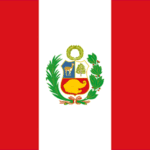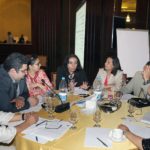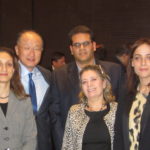This post is also available in: ArabicSpanish
In 2014, the World Bank Group (“WBG” or “the Bank”) introduced a new Country Engagement approach, in line with the 2013 WBG Corporate Strategy that aims to streamline operations across the institution (public and private sector) and focus all operations moving forward on two goals of reducing absolute poverty and boosting shared prosperity.
The new approach replaced the Country Assistance/Partnership Strategy with the Country Partnership Framework and formally took effect on July 1st 2014.
This resource is designed to give a basic understanding of the new approach, and outline how citizens in countries can play a role in setting the WBG’s agenda in their country.
BIC is working on this issue on two levels, each feeding into the other: at the policy level BIC is working closely with other civil society organizations (CSOs) to understand and try to influence the Bank’s new approach, including the associated Directives and Guidance. In May 2014 BIC led a joint CSO submission outlining a set of recommendations on the Country Engagement approach to the World Bank and is continuing to stay engaged in the process. In addition, BIC contributed recommendations to feed into the Systemic Country Diagnostic (SCD) guidelines revision. Read our Recommendations, submitted with Oxfam and Center for International Environmental Law, here.
BIC is also working with CSOs in select countries to help them influence and become engaged in the CPF processes taking place in their countries. BIC has published a CSO guide presenting background information on the Bank’s country engagement approach, including the requirement to consult; case studies from Peru and the MENA region; and a step-by-step approach for how CSOs can engage.
Updates
 Country Partnership Frameworks – Influencing World Bank Investments ‘Upstream’
Country Partnership Frameworks – Influencing World Bank Investments ‘Upstream’This post is also available in: ArabicSpanishWorld Bank projects and policies af...
 Workshop on Peru World Bank Country Partnership Framework co-organized by BIC, DAR and AIDESEP “Reformas Globales y Alcances Nacionales”
Workshop on Peru World Bank Country Partnership Framework co-organized by BIC, DAR and AIDESEP “Reformas Globales y Alcances Nacionales”This post is also available in: ArabicSpanishLima, Peru. January 24, 2017 Summar...
 Update: World Bank Should Release Draft of Country Partnership Framework for Meaningful Consultation
Update: World Bank Should Release Draft of Country Partnership Framework for Meaningful ConsultationThis post is also available in: ArabicSpanish January 11, 2017 The World Bank is...
 Update: World Bank Consultations on Peru’s Country Partnership Framework (CPF)
Update: World Bank Consultations on Peru’s Country Partnership Framework (CPF)This post is also available in: ArabicSpanishThe World Bank Group is in the proc...
 La Banque s’engage en Tunisie à clore la boucle de rétroaction
La Banque s’engage en Tunisie à clore la boucle de rétroactionThis post is also available in: ArabicSpanishCe message est également disponible...
 Egyptian CSOs and the World Bank’s New Country Partnership Framework for Egypt
Egyptian CSOs and the World Bank’s New Country Partnership Framework for EgyptThis post is also available in: ArabicSpanishIn December 2015, the World Bank Bo...
 The Role of Civil Society in drafting the World Bank’s New Strategy in Tunisia
The Role of Civil Society in drafting the World Bank’s New Strategy in TunisiaThis post is also available in: ArabicSpanishThis post is also available in: Fre...
 Le rôle de la société civile dans l’élaboration de la nouvelle stratégie de la Banque mondiale en Tunisie
Le rôle de la société civile dans l’élaboration de la nouvelle stratégie de la Banque mondiale en TunisieThis post is also available in: ArabicSpanishCe message est également disponible...
 Rencontre de Représentants de la Société Civile Tunisienne avec le Président de la Banque Mondiale
Rencontre de Représentants de la Société Civile Tunisienne avec le Président de la Banque MondialeThis post is also available in: ArabicSpanishCe message est également disponible...
 Tunisian Civil Society Representatives Meet with World Bank President
Tunisian Civil Society Representatives Meet with World Bank PresidentThis post is also available in: ArabicSpanishThis post is also available in: Fre...
Background
What is a Country Partnership Framework?
In terms of objectives, the Bank may identify in the CPF specific sectors that it plans to focus programming on, for example agriculture or energy, or it may identify broader objectives such as enhancing service delivery. In the past, CASs and CPSs have been quite broad in their objectives and the Bank states that it will move towards a more selective approach with the CPF.
What is the process for developing a Country Partnership Framework?
In sum, key inputs to the CPF include: the SCD; the government’s development plan; other donors’ plans; and stakeholder consultations. After a final draft of the CPF is completed by the World Bank country team and has been signed off on by the Regional Vice President and the Managing Director, it will then be sent to the Bank’s Board of Directors for discussion. If your government has given the Bank “simultaneous disclosure” approval, the final draft of the CPF will be disclosed to the public at the same time it is sent to the Board. Otherwise it will be disclosed after the Board discussion.
After the Board date, the CPF will come into effect, and the Bank can start negotiating, designing, and financing projects to invest in at the country level as well as provide technical assistance to the government and private sector. The Bank will periodically conduct Performance and Learning Reviews (PLRs) to assess how the CPF is being implemented and whether the objectives, results framework or CPF timeline need to be adjusted and how. At the end of the CPF period (between 4-6 years), the Bank will produce a Completion and Learning Report (CLR), which assesses the results of the CPF and should be used to feed into the next CPF.
What is the Systematic Country Diagnostic?
Why should civil society care about the Country Partnership Framework?
Concerns
BIC and several other organizations sent materials to the World Bank Group outlining their recommendations and concerns with the new approach. BIC’s comments, which were jointly submitted with Oxfam International and the Center for International Environmental Law, can be found here , while the overall summary of recommendations that the Bank received during the consultation phase are outlined here.
Many of civil society’s recommendations were adopted in the updated Country Engagement Directives and Guidance, including making clearer the Bank’s mandate to consult with citizens during the preparation of the SCD, the CPF and the PLR, and a commitment to consider environmental and social risks of the proposed CPF objectives. On the other hand, there are still some lingering questions around other important areas that do not seem to have been addressed in the updated documents, including the following:
On risk, the Bank seems to be focused more on the risks to the CPF objectives, rather than those that could result because of CPF objectives. While this is not necessarily going to be the case in every country, it seems to be the focus in the Bank’s discussion of risk. The risks that the Bank is seeking to identify are outlined in the Interim Guidance Note for the Standardized Operational Risk Rating Tool (SORT).
On consultation with civil society, while we are pleased that the Bank is now mandating consultation across the different stages of the CPF preparation and implementation and recommends that staff use the Bank’s Consultation Guidelines for details on how best to undertake inclusive consultations, ultimately, the quality of consultations will vary significantly from one country to another because it is up to each country team to determine how to consult on the CPF. This may result in some less than perfect consultations. For example, in Burma/Myanmar, CSOs had these concerns with the SCD consultation that took place there. Whenever possible, it is important to monitor, document, and demand excellent consultations and be prepared to engage in order to demonstrate the value of civil society consultations.
On implementation, the Bank states that it is committed to achieving results on the ground and that a portfolio review will inform its Performance and Learning Reports (PLRs) through this new approach, but it has yet to commit strongly to strengthening in-field supervision and monitoring and evaluation (M&E) in both public and private sector operations. The Bank has specified that CPFs may include a discussion on special M&E mechanisms an that citizens’ voices will be incorporated into PLRs but it is unclear how much information will be sought by those citizens who are directly and indirectly impacted (either positively or negatively) by the portfolio. It is our hope that the Bank will systematically seek direct feedback using tools outlined in the Bank’s own new Citizen Engagement Strategy in a serious way.
Action
There are a few ways that civil society can be involved.
- Provide input to the World Bank about the new Country Engagement Approach. While the directives are completed, the Bank continues to receive feedback and questions on the new approach and is committed to “learn through doing”. Moreover, the Systematic Country Diagnostic guidelines are still considered interim rather than final. Send feedback to cpf@worldbank.org.
- Find out more information about when the Bank is in developing a CPF for your country. To find contact information for your local World Bank office, go to www.worldbank.org/YourCountyName and the contact information will be at the left. If you then click on “Overview” also at the left, and you will find information about this country’s CAS/CPS/CPF under the “Strategy” tab.
- Visit the Bank’s consultations hub page at consultations.worldbank.org to see if it is holding consultations for any strategy, policy or project in your country.
- Find out which projects the Bank is financing in your country and become involved in monitoring how the Bank is implementing its CPF. This is useful not only to see if results are actually being achieved on the ground but also for the Bank to hear citizens’ feedback on its portfolio. It is also important in case there are negative impacts of a project that ought to be addressed.
- To find out which projects are being financed in the public sector: Go to your country page which is www.worldbank.org/[your country name]. Click on Projects and Programs at the left. In the Projects and Programs page click on “View All Projects” under the search box.
- To find out which projects are being financed in the private sector: Go to www.ifc.org and under the “Projects” tab click on “Disclosed Projects”. On the next page, click on “Search Projects” in the left-hand column. In the search function, choose your country from the drop-down list and make selections in any other categories you are interested in or simply leave them blank. Click Search.
Resources
BIC analysis and resources
Country Partnership Frameworks – Influencing World Bank Investments ‘Upstream’, July 2017 (BIC)
Recommendations for Guidelines for Systematic Country Diagnostic, December 2015 (BIC, Oxfam, Center for International Environmental Law)
An Introduction to Country Partnership Frameworks
Egypt Country Partnership Framework
Child Rights and the Country Partnership Framework
Joint submission to the World Bank Group on its new country engagement approach, May 2015 (BIC, Oxfam, Center for International Environmental Law)
World Bank documents
Country Engagement Directive, World Bank Group, July 1, 2014
Country Partnership Framework Guidelines, World Bank Group, July 1 2014
Interim Guidelines for Systematic Country Diagnostic, World Bank Group, February 21, 2014
Interim Guidance Note for Operations Risk Tool, World Bank Group, June 25, 2014
List of Planned Systematic Country Diagnostics for 2017
Related Webpages

